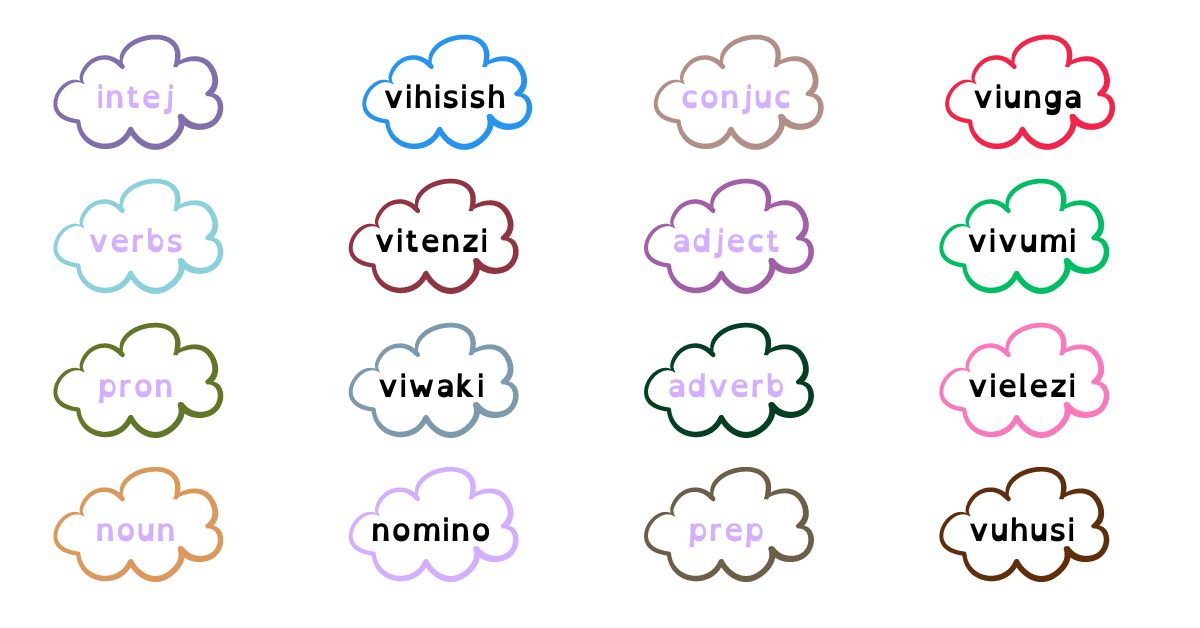There are eight types of words (aina za maneno) in Kiswahili. The last time I learned these, I was in form 2, so I understand if you don’t remember anything from your Kiswahili class. But that’s why I’m here. Today, I will take you through aina za maneno na mifano yake with the help of Tr. Meshack from Moi Forces Academy. Let’s get started
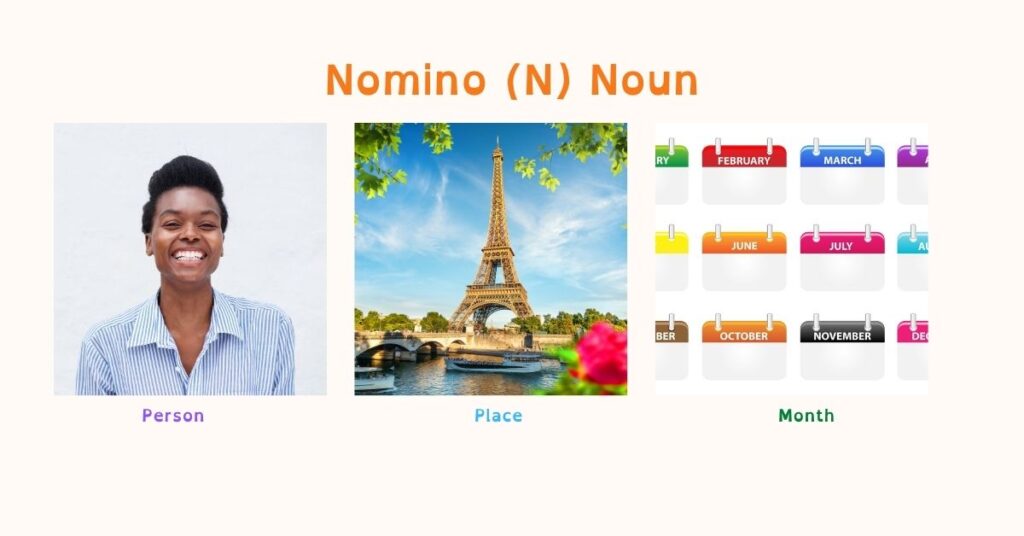
- 1. Nomino (N) Noun
- 2. Vivumishi (V) Adjectives
- 3. Viwakilishi (W) Pronoun
- 4. Vitenzi (E) Verbs
- 5. Vielezi (E) Adverb
- 6. Vuhusishi (H) Prepositions
- 7. Viunganishi (U) Conjunctions
- 8. Vihisishi (I) Interjections
1. Nomino (N) Noun
Nomino is a noun. A noun is a word that names a person, place, thing, idea, or quality. Nouns are the building blocks of sentences and play a crucial role in conveying meaning.
In Kiswahili, a noun, or nomino is described as “neno linalotaja mtu, mahali, kitu, wazo, au sifa.” For example, Mary and Nairobi are nouns.
Like their English equivalent, there are different types of nouns. These include:
Nomino za Kawaida or Common Nouns
Common nouns are words used to name general categories of people, places, things, ideas, or qualities.
Kiswahili definition: “Nonimo za kawaida ni maneno yanayotumiwa kurejelea vitu vya kawaida kama watu, wanyama, na mahali.”
For Example (Mifano Ya Nomino)
| Nyumba | House |
| Mbuzi | Goat |
| Mtu | Person |
| Shati | Shirt |
Mifano Ya Nomino za Kawaida Katika Sentensi (Examples in a Sentense)
| Nyumba yao imechomeka Their house burned down | Nyumba House |
| Jua limewaka The sun is out | Jua Sun |
| Mwalimu anafunza vyema darasa lake The teacher is teaching her student’s well | Mwalimu, darasi Teacher, students |
| Mtoto analilia maziwa na wali The child is crying for milk and rice | Mtoto, maziwa, wali Child, milk, rice |
| Mbwa amekimbia haraka na mfupa wake The dog is running with it’s bone | Mbwa, mfupa Dog, bone |
Zoezi la Nomino za Kwaida (Exercise)
| Watoto wanasoma kitabu |
| Mtu huyu ni mrefu sana |
| Rununu na runinga ni vyombo vya mawasiliano |
| Baba na mama wana vitu vitatu |
| Kikombe changu ni cha rangi ya manjano |
Nomino za Pekee (Proper Nouns)
A proper noun is the name of a person, place, city, or company. In Kiswahili or English, proper nouns start with a capital letter.
Kiswahili definition: “Nomino ya pekee ni majina mahususi ya watu, mahali, kampuni, na bidhaa.”
Mifano Ya Nomino za Pekee (Examples)
| Nairobi | Name of a city |
| Stacey | Name of a person |
| Safaricom | Name of a company |
| January, Monday January, Jumatatu | Name of months and days of the week |
| God, Mola, Adonai | Names of God |
Mifano Ya Nomino za Pekee Katika Sentensi (Examples in a Sentence)
| Maria na Yohana wanasherehekea ndoa yao Mary are John are getting married | Maria, Yohana Mary, John |
| Ziwa Victoria limejaa kuliko bahari Hindi Lake Victoria has more water than the Indian Ocean | Ziwa Viktoria, bahari Hindi Lake Victoria, Indian Ocean |
| Anasoma katika shule ya msingi ya Parklands. His school is called Parklands Primary | Parklands Primary |
| Uchina na Kenya zishirikiana kwa karibu sana China and Kenya have a close relationship | Uchina, Kenya China, Kenya |
| Mwalimu Juma anakuja darasani Teacher Juma is coming to class | Mwalimu Juma Juma |
Zoezi la Nomino za Kwaida (Exercise)
Can you identify the nomino za kawaida in these sentences?
| Mungi ni mkuu kuliko wote |
| Liam alienda shuleni |
| Tanzania, Kenya, Uganda, na Rwanda ni nchi za Afrika Mashariki |
| Tutaenda shule jumatatu hadi Alhamisi |
| Bibilia na Koroani ziko wapi? |
Aina Nyingine Ya Nomino (Other Types of Nouns in Kiswahili)
- Nimoni za wingi (uncountable nouns) eg maji (water), upendo (love)
- Nomino za jamii (collective nouns) – e.g. kundi (group), msitu (forest)
- Nomino za dhahania (abstract nouns) – e.g. upendo (love), heshima (respect)
We have a comprehensive post on aina za nomino na mifano zake that you can read to find more information on nomino and exercises.
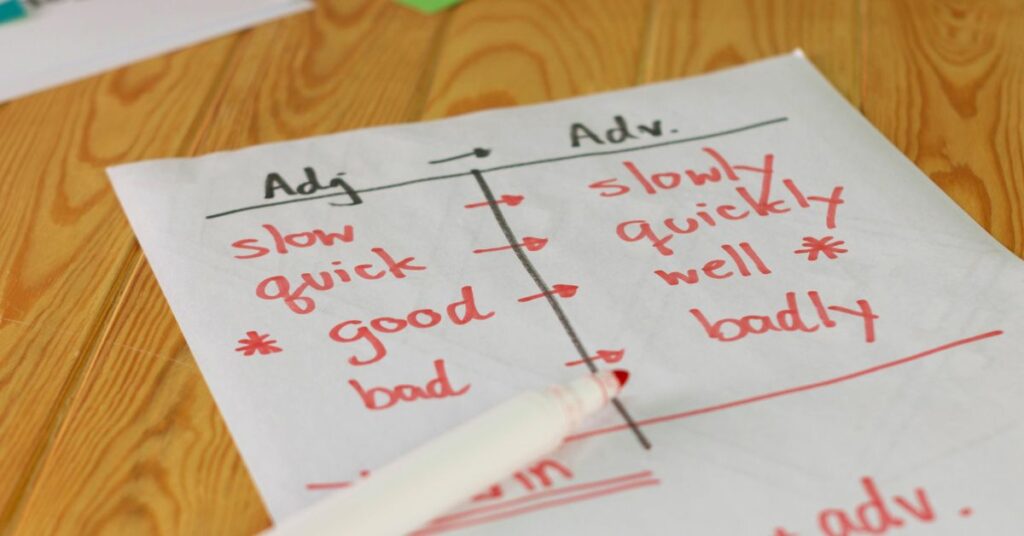
2. Vivumishi (V) Adjectives
Vivumishi or adjectives are words that describe or modify nouns or pronouns. They provide more information about the characteristics, qualities, or states of being of the subject they refer to.
Kiswahili definition:
“Vivumishi ni maneno yanayotoa maelezo zaidi kuhusu nomino au viwakilishi“
Tr. Meshack Sindani ~ Moi Forces Academy
Also read: Vitendawili na Majibu
Vivumishi vya Sifa (Descriptive Adjectives)
Vivumishi vya sifa are adjectives that describe the qualities or characteristics of a person, thing, or place. They provide more information about how a thing looks, feels, tastes, smells, sounds, or acts.
Kiswahili definition: “Vivumishi vya sifa ni maneno ambayo hutoa sifa kuhusu mtu, kitu, au mahali.”
For Example (Mifano Ya Vivumishi Ya Sifa)
| Zuri | Beautiful |
| Dogo | Small |
| Mpya | New |
| Safi | Clean |
| Tamu | Sweet |
There are a few rules you need to remember. First, vivumishi vya sifa are used with proper nouns (nomino ya pekee) or adjectives used to describe the proper noun (kiwakilishi husika.)
Secondly, vivumishi vya sifa have to take prefixes of a specific noun class. That is, “vivumishi vya sifa huchukua viambishi vya ngeli husika, kuleta maana ya kivumishi.”
For instance, you can’t say mtoto fupi. Instead you’d say, mtoto mfupi. The “m” in “mfupi” is the kiambishi cha ngeli (prefix) and is used to bring meaning to “fupi” which is the kivumishi cha sifa or descriptive adjective.
Mifano Vivumishi vya Sifa Kwenye Sentensi (Examples in a Sentence)
| Mama yangu hupika chakula kitamu My mother makes sweet food | Kitamu Sweet |
| Yule mvulana mweusi anasomea shuleni mwetu That black boy goes to our school | Mweusi Black |
| Lile tunda jeupe ni tamu sana That white fruit is very sweet | jeupe, tamu White, Sweet |
| Chakula kitamu kilipakuliwa kwenye harusi There was sweet food at the wedding | kitamu Sweet |
| Simu nyeupe ndio hii. Nyekundu iko pale. This is the white phone. The red one is over there. | Nyeusi, nyekundu Black, White |
Zoezi la Vivumishi vya Sifa (Exercise)
Can you identify the vivimishi vya sifa in the following sentences?
Also read: 13 Fun Games to Strengthen Early Swahili Reading Skills
| Niliona ndege mkubwa mwenye mabawa meupe akiruka juu angani. |
| Mtoto mdogo alikuwa akicheza na mpira mwekundu. |
| Wimbo mzuri ulimfurahisha kila mtu aliyekuwa kwenye sherehe |
| Kitanda cheupe ni kizuri kuliko kitanda cheusi. |
| Yule msichana mrefu ana tabia nzuri ya kusaidia wenzake. |
Aina Nyingine Ya Vivumishi (Other Types of Adjectives)
- Vivumishi vya Pekee e.g mwenye, mwenyewe, wote, wowote, ingine, ingineo
- Vivumishi virejeshi eg mtoto ambaye
- Vivumishi vya vimilikishi (possessive) eg wangu, wako, wake
- Vivumishi vya idadi (measure) eg wawili, wengi, watatu
- Vivumishi visisitizi (emphasis) mtoto yuyu huyu, watoto wale wale
- Vivumishi viulizi (question) kipi?, gani?, yupi?

3. Viwakilishi (W) Pronoun
Pronouns are words that take the place of nouns in a sentence. They are used to avoid repetition and make sentences flow more smoothly.
Kiswahili definition: “Viwakilishi ni maneno yanayotumiwa badala ya nomino.”
For example, instead of saying Beth ni mtoto mrembo (Beth is a beautiful child), you say “yeye ni “mtoto mrembo” (she is a beautiful child.)
Another example is mwalimu ametoka (the teacher has left) becomes yeye ametoka or (he has left.)
Interestingly, viwakilishi and vivumishi have the same subtypes. The difference is, in viwakilishi, there are no nouns. You instead use the kiwakilishi (pronoun).
Also, note that you cannot use a kiwakilishi (pronoun) together with a nomino (noun). You can only use either or.
Also read: How to Improve Math Skills and Reading for Kindergarten Kids
Viwakilishi vya Nafsi
Viwakilishi vya sifa are grouped into three categories. We have:
| Nafsi ya I (first person) | Mimi I | Sisi We |
| Nafsi ya II (second person) | Wewe You | Nyinyi |
| Nasfi ya III (third person) | Yeye Him/her | Wao |
This means, you use the viwakilishi in singular (umoja) and plural (wingi).
Mifano ya Viwakilishi vya Nasfi (Examples)
Nasfi ya kwanza
| Mimi ni mrembo | Sisi ni warembi |
| Mimi nilitembea | Sisi tulitembea |
| Mimi nilikunya maji | Sisi tulikunywa maki |
Nafsi ya Pili
| Wewe ni mrembo | Nyinyi ni warembo |
| Wewe ulitembea | Nyinyi mlitembea |
| Wewe ulikunywa maji | Nyinyi mlikunywa maji |
Nasfi ya Tatu
| Yeye ni mrembo | Wao ni warembo |
| yeye alitembea | Wao walitembea |
| Yeye ulikunywa maji | Wao walikunywa maji |
Aina Nyingine ya Viwakilishi (Other Types of Nouns in Kiswahili)
- Vivumishi vya Pekee eg mwenye-mwenyewe, wote- wowote
- Vivumishi virejeshi eg mtoto ambaye
- Vivumishi vya vimilikishi (possessive) egwangu, wako, wake
- Vivumishi vya idadi (amount) eg wawili, wengi, watatu
- Vivumishi visisitizi (emphasis) mtoto yuyu huyu, watoto wale wale
- Vivumishi viulizi (question) kipi, gani, yupi
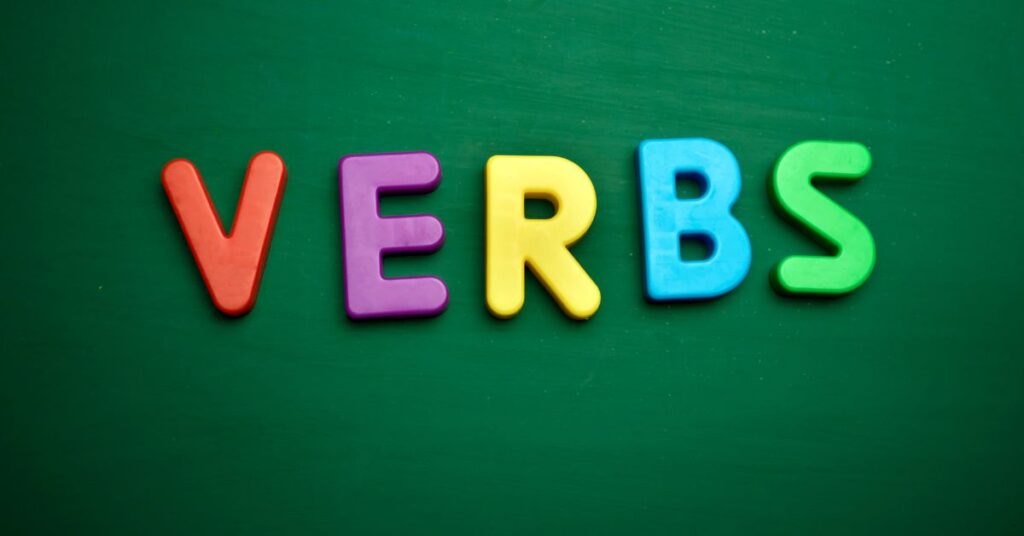
4. Vitenzi (E) Verbs
Verbs are words that describe actions, occurrences, or states of being. They are essential components of sentences because they tell us what is happening, what exists, or what condition something is in.
Kiswahili definition: “Vitenzi ni maneno yanayoeleza matendo yanayofanyika, yaliyofanyiksa, na yatakayofanyika.”
In translation, vitenzi tell us what has happened, what happened, and what will happen. The subtypes include:
Vitenzi Halisi
Vitenzi halisi, mostly used by itself, shows how an action is happening.
| Mwanafunzi anasoma kitabu | anasoma |
| Ndege wanaruka | wanaruka |
| Mtoto anacheka | Anacheka |
Vitenzi Vikuu na Visaidizi
These are vitenzi vikuu na visaidizi (main verbs and auxiliary verbs). Vitenzi vikuu (main verbs) carry the essential meaning of an action, occurrence, or state of being in a sentence, while vitenzi visaidizi (auxiliary verbs) help the main verb.
| Watoto walikuwa wanacheza nje usiku mzima | wanacheza | walikuwa |
| Juwa lilikuwa linawaka sana | linawaka | lilikuwa |
| Baba napenda kula chakula nachopika mwenyewe | anapenda | kula |
Vitenzi Vishirikishi
Vitenzi vishirikishi describe an existing state or context and are also used to describe the environment.
| Huyo si mtoto wangu | si |
| Yeye ni mrefu | ni |
| Wao si wanafunzi | si |

5. Vielezi (E) Adverb
Adverbs (vielezi) add more information to verbs, adjectives, other adverbs, or even entire sentences.
The Kiswahili definition is “vitenzi ni maneno yanayoonyesha jinsi tendo linavyo tendeka,” which is loosely translated as words that show how an action is taking place.
Like adverbs, vielezi answer the questions on how (vipi), where (wapi), when (lini), and how many (mara ngapi.)
The subtypes include:
- Vielezi vya wakati
- Vielezi vya mahali
- Vielezi vya namna
- Vielezi vya idadi
Mifano Ya Vielezi Katika Sentensi
Vielezi vya Wakati
| Tutamtembelea bibi kesho | Kesho |
| Jana liona kobe | Jana |
| Tutakutana Ijumaa | Ijumaa |
Vielezi vya Idadi
| Mwalimu alitufunza mara tatu wiki iliyopita | tatu |
| Alikula robo ya mkate | robo |
| Watu wachache walienda kwenye harusi hiyo | wachache |
Vielezi vya Mahali
| Wanafunzi wameingia darasani | Darasani |
| Tutakutana mbele ya maktaba | Makataba |
| Aliweka simu ya mama mezani | Mezani |
Vielezi vya Namna
| Mama alipika chakula upesi | upesi |
| Alickeka kijinga | lijinga |
| Alitembea kijeshi | kijeshi |

6. Vuhusishi (H) Prepositions
Prepositions are words that establish relationships between other words in a sentence. They typically show the location, direction, time, or manner of something in relation to another word.
The Kiswahili definition is, “vihusishi ni maneno yanayoonyesha uhusiano wa kitu na kingine au mtu na mwingine. Uhusiano huu unaweza kuwa wa mahali, wakati, au kiwango.” This can be loosely translated to mean vihusishi show the relationship between things or people. The relationship could be that of time, place, or quantity.
For instance, in the sentence “Paka yuko chini ya meza,” chini ya (under the ) shows the relationship between Paka (cat) and meza (table). The English equivalent of this sentence would be “The cat is under the table.”
The subtypes include:
- Vihusishi vya mahali which show the relationship between a noun and its place. For example, kiti kimo ndani ya daraka, usiende karibu na mto ule.
- Vihusishi vya wakati, which show the relationship between a noun and time. For example, wanafunzi walifika kabla ya macheo, watarudi baada ya kusoma.
- Vihisishi vya kunyume which show the oppposite of an action. For example, alienda shambani badala ya sokoni, badala ya kuenda mjini, alienda nyumbani.
- Vihusishi vya kufananisha which shows comparison. For instance, anasoma Bibilia kama kasisi.
- Vihusishi vya sababu which show the reason for something. For example, siuoni kwavile amejificha.
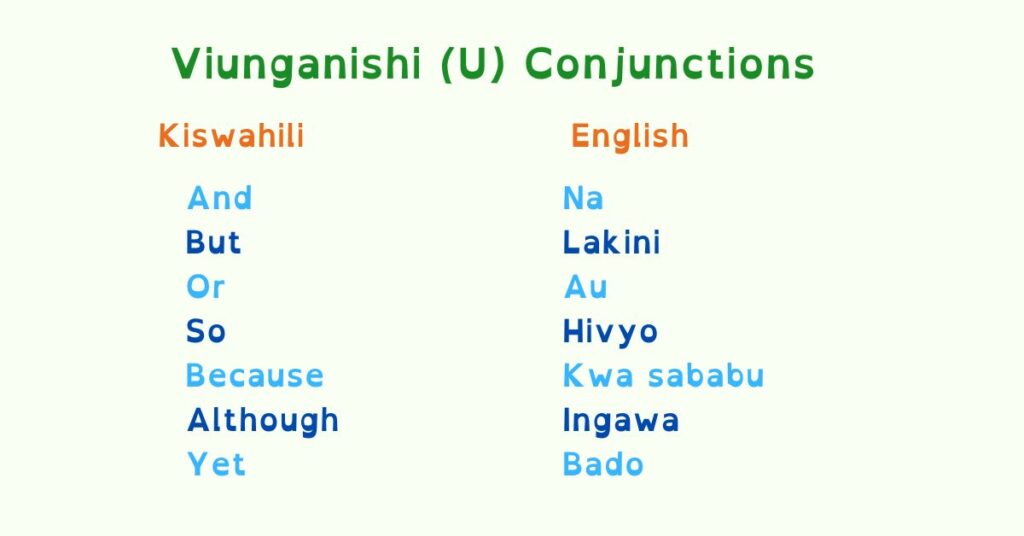
7. Viunganishi (U) Conjunctions
Conjunctions are words that connect words, phrases, or clauses in a sentence. They play a crucial role in building grammatically correct sentences and creating relationships between different elements.
The Kiswahili definition is, “viunganishi ni maneno yanayounganisha maneno mengine au sentensi.” for example, in the sentence, Mama anapika na kuongea, the words “na” is a conjunction (kiunganishi.)
The sub-types include:
| Subtype | Sentence | Kiunganishi |
|---|---|---|
| Viunganishi vya umilikaji | Kiatu cha mzee kimerarukaSifiria ya mama imeibiwa | Cha _______ (your answer) |
| Viunganishi vya kujumlisha | baba na mama wameenda kanisani. Mwizi aliiba runinga pamoja na redio. | Na ________ |
| Viunganishi vya kutofautisha | Ongea naye ila usimwambie mipango yetu Aliondoka bila kusema lolote | Ila ________ |
| Vihisishi vya sababu | Mchezaji aliumizwa kwa vile alikuwa tisho kwa timu hiyo. Niliwafunza ili wapite mtihani. | Kwavile ________ |
| Vihusishi vya kulinganisha | Kunywa pombe nikama kujichimbia kaburi mwenyewe. Ben ni mfupi kuliko Peter. | Nikama ________ |
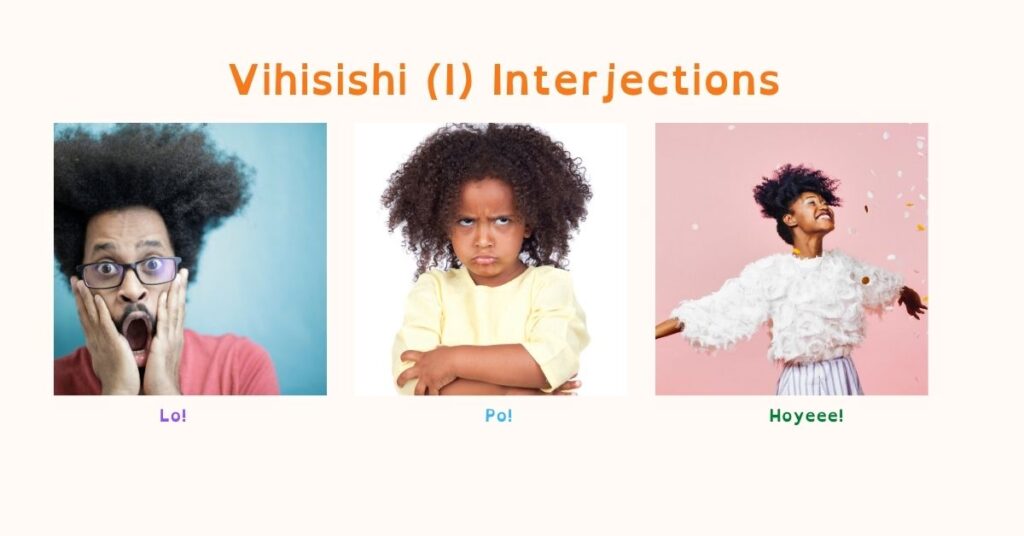
8. Vihisishi (I) Interjections
Interjections are words or short phrases used to express sudden emotions, reactions, greetings, or sounds. The kiswahili definiton is “vihisishi ni maneno yanayoonyesha hisia.” For example, interjections (vihisishi) can show happiness (furaha) shock (mshangao), and anger (hasira.)
While they don’t have sub-types, the table below can show you different vihisishi and the emotions they show.
| Kihisishi | Mfano Katika Sentensi | Hisia |
|---|---|---|
| Lo! | Lo! Maajabu ya Musa haya! | mshangao |
| Salaale!, Masalaale! | Salaale! Angalia watu wote hawa waliofika mahali hapa! | mshangao |
| Kumbe! | Nilidhani wewe ni rafiki yangu. Kumbe! | mshangao |
| Po! | Sijawahi kuona kijana mjeuri kama wewe. Po! | hasira |
| Ng’o! | Omba msamaha utakavyo, lakini unachoka bure. Ng’o! | kiburi |
| Hata! | Bwanake hakumwachia chochote! Hata! | kusifia, kupuuza |
| Akh!, Aka! | Mtoto mpumbavu huyu! Akh! | hasira, kukashifu |
| Ah! | Ah! Sikuyaamini macho yangu. | mshangao |
| Ala! | Ala! Umefika tayari! | mshangao |
| Haha! | Haha! Umenivunja mbavu, bwana! | kicheko |
| Ehee!, Enhe! | Enhe! Endelea, ninaipenda sana hadithi hiyo! | kuitikia |
| Hmmm! | Hmmm! Chakula kitamu hicho! | kuitikia, kusifia |
| Ebo! | Ebo! Tabia gani hiyo. | kukashifu, hasira |
| Kefule! | Kefule! Umenifedhehesha sana. | hasira |
| Wee! | Katamu alinegua kiuno na kucheza kwa madaha. Wee! Wavulana wakaduwaa. | kusifia |
| La!, Hasha! | La! Sitaki kusikiliza upuuzi wako tena. | kukataa |
| Hoyeee! | Wamama wote, hoyee! Hoyee! | kushangilia |
| Huraa! | Huraa! Tumeshinda. | kushangilia |
I hope this overview of aina za maneno (types of words) is helpful for you and your child and will assist with their homework. If you need exercises and more examples, please comment below, and they will be provided. Alternatively, you can read the blog posts that individually expound on each type of words and provide more examples.
Kuna aina nane (8) za maneno. Hizi ni nomino, vivumishi, viwakilishi, vitenzi, vielezi, vihusishi, viunganishi, na vihisishi.

